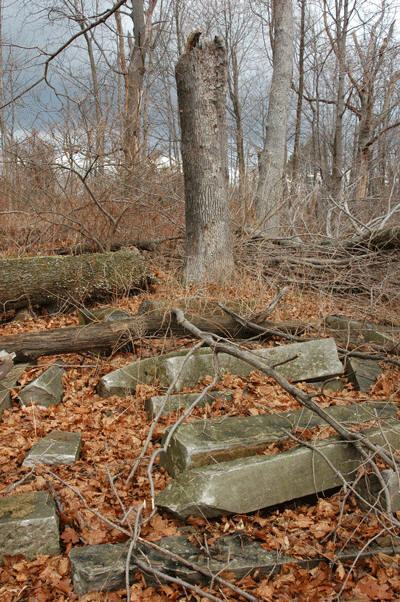How to Mix a Zabriskie
A “Cliff Notes” Story
January 2012
It’s the coldest day of the winter so far, and we’ll be walking across the George Washington Bridge into Manhattan. The idea is to get to the library of the New-York Historical Society, to see if we can take a look at a certain book we know they have. The book was compiled in 1933 by George A. Zabriskie, who owned “Cliffdale,” the big 1911 estate whose two-story foundation ruins still intrigue hikers who come upon them along the Long Path. (As we drive down 9W to Fort Lee, we pass the entrance to Cliffdale: a pair of gray stone columns slowly crumbling above the shoulder.) The Bridge isn’t as bad as we feared, the wind at our backs, from the west; there are times when we’re walking faster than the inbound morning traffic. Funny to realize that this bridge, eighty years old this year, is the primary reason Cliffdale met its end: When the bridge opened in October 1931, the Interstate Commission, realizing the pressure for development the big gray span would generate, set out to acquire the lands on top of the Palisades and return them to their natural condition. Cliffdale was among a dozen or more grand estates so acquired — and demolished.

The subway takes us to 81st Street, then a short walk past the Natural History Museum to the Historical Society. Tourists are everywhere, in this between-the-holidays week.
It’s a bit like walking in Zabriskie’s steps into the grand, towering-ceilinged rooms of the Historical Society — of which he was president for years. After checking our coats like the rest of the visitors, we find our way to the library, where we place a request for that certain book. While we wait, we admire shelves of volumes we can see high above us on balconies reached by a peculiarly long, twisting staircase that belongs in a storybook. After a few minutes, the research librarian appears with the volume in hand — The Bon Vivant’s Companion : or, How to mix drinks, containing directions for mixing most of the beverages used in America, with the most popular British, French, German, Italian, and Spanish recipes embracing cocktails, punches, juleps, cobblers, etc. in endless variety. It’s an elaborate Christmas card, over eighty pages bound in brightly colored leather covers “Compiled for His Friends by George A. Zabriskie” from his winter home (Cliffdale was a summer residence), “The Doldrums, Ormond Beach, Florida.” There is a “Dear ______” space left for a friend’s name to be written above the introduction, but this copy has no name there; the end pages, left blank by the printer, have been filled with recipes added after 1933. Other copies of the Companion have also survived and can be found at the New York Public Library and elsewhere — but this was George’s own copy!
The introduction reminds us that “In all ages of the world, and in all countries, men have indulged in ‘Social Drinks,’” but “whether it is judicious that mankind should continue to indulge in such things … it is not my province to decide.” He nevertheless shows his feelings on the matter with how he concludes the introduction — while also providing a succinct reminder of time and place: “the Eighteenth Amendment [i.e., Prohibition] will soon be a dream. Drink hearty, and best wishes for a Merry Christmas and a Happy New Year.”
Along with recipes for “green Swizzles” and “Montana Clubs” – for “Bronx Terraces” and “Knickerbockers” – for “Tuxedos” and “Zazas” and “Vermouth Frappes” – are witticisms and snatches of poems and limericks –
Let school-masters puzzle their brains
With grammar, and nonsense and learning —
Good Liquor I stoutly maintain —
Gives genius a better discerning.
— a discussion of the term “cocktail” and its origins, even a chapter about famous Americans — Washington, Franklin — and their propensities to quaff a drink or two (there is a hilarious anecdote about a drunken Daniel Webster greeting a fish he caught on his line as though it were the Marquis de Lafayette).
The end pages, filled in with neat penmanship, reflect the passage of the years. Among the added drinks are a “Scarlett O’Hara,” “America’s 1939 Cocktail with a Southern accent,” featuring Southern Comfort, lime, and a little whipped cream, for “the delicate scent of Magnolia blossoms, concealing the heels of a Missouri Mule”; a “World War II Invasion Cocktail” to commemorate the D-Day Allies with Bourbon (U.S.A.), Scotch (U.K.), and Vodka (U.S.S.R.); and a pasted-in, post-Hiroshima news clipping about an “Atomic Cocktail.”
In the spirit of historical inquiry, then, we’ve provided a few recipes from The Bon Vivant’s Companion (see sidebar), along with this little New Year’s toast from its pages:
Here’s a toast to all who are here,
No matter where you’re from:
May the best day you have seen
Be worse than your worst to come.
– Lindsey Foschini-Stabile & Eric Nelsen –

